Choosing a batch of world famous photos is really complex but really fun to do because studying images is, for me, the best way to learn about photography in its essence. Photography, for me, is about capturing meaningful stories and nothing more. It is completely normal to expect readers to comment on the inclusion or exclusion of certain images.
The purpose is not to exclude or include but to mention world famous photos that have been renowned as iconic due to their social and anthropological importance.
Photography is a way of feeling, of touching, of loving. What you have caught on film is captured forever… It remembers little things, long after you have forgotten everything.
Aaron Siskind
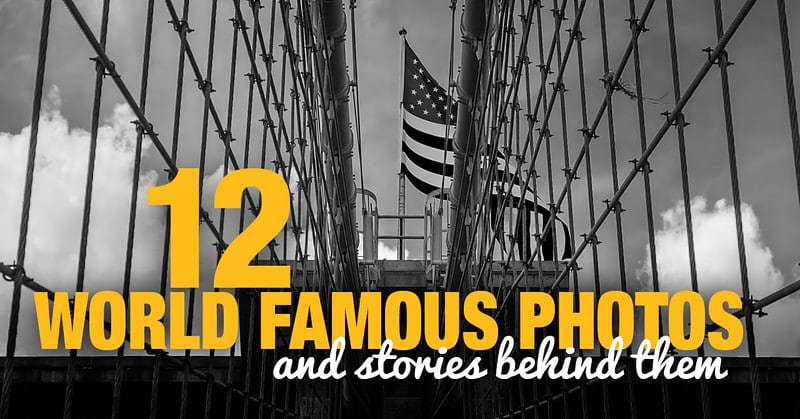
To me, photography is an art of observation. It’s about finding something interesting in an ordinary place… I’ve found it has little to do with the things you see and everything to do with the way you see them.
Elliott Erwitt
A tear contains an ocean. A photographer is aware of the tiny moments in a person’s life that reveal greater truths.
Anonymous
Get Inspired by World Famous Photos
Please feel free to share other images that could be considered as historically important in order to get a richer experience through the social development of these words. Without further ado, let’s talk about some world famous photos.
1. Sharbat Gula – Steve McCurry – 1984
Published for the first time in 1985, the iconic portrait of a young Afghan girl, a refugee from the war, still evokes a deep and complex mix of feelings and emotions to this day. After seventeen years, Steve McCurry found her and portrayed her again.
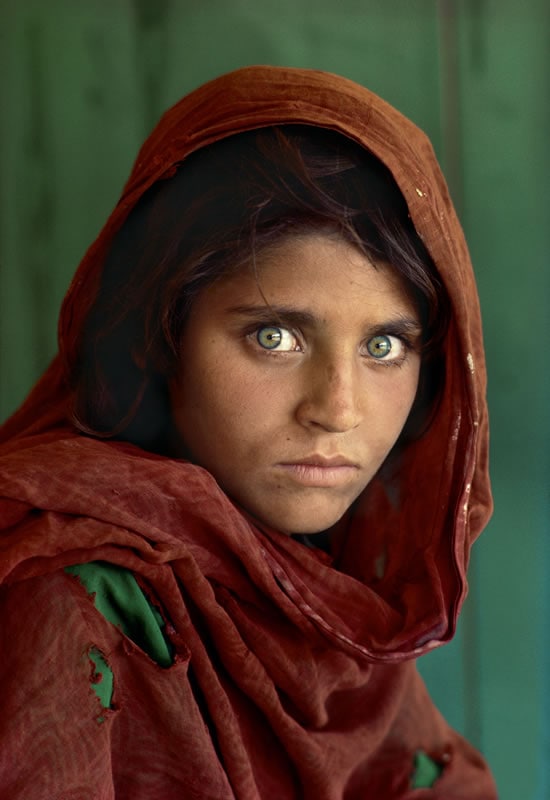
This image is the most superb portrait of all time for me. This is due to many factors, but the primary one is that eerie feeling of indefinite expression (I guess this is why some people have likened this picture to the modern Mona Lisa).
The moment Steve McCurry captured is so intense that I can only guess that it’s evidence of the transition between recognizable emotions. Her beautiful green eyes, her skin, her hair, her fragile clothes, the outstanding sharpness of the image, the complementary colors, her soul-piercing look—everything in this picture speaks.
I remember when I first saw this photo, I imagined Steve McCurry running on a random street and capturing this image almost candidly. Later, I learned that it wasn’t like that, and it doesn’t matter to me; this portrait is sublime and perfect; it speaks to the universality of the human being.
A couple of years ago, I watched this video and understood the importance of having agile and well-intended social skills in order to capture meaningful pictures.
Steve McCurry wasn’t dashing away from bullets like a superhero as portrayed when I first saw this image (at least with photographic awareness of what it could have implied capturing an image like this one in the midst of a war context). Instead, he was at a school, and he managed to make her almost want the picture. His skills were beyond amazing. We often have the misconception that kids don’t understand things and can easily be fooled. But kids don’t lie, and they possess a lot of temperament and character, which is clearly tangible in the iconic portrait of Sharbat Gula. And after 17 years, he found her again.
And for the tech-savvy and curious individuals, he shot this image with the legendary Kodachrome film, using a Nikon FM2 and a trusty Nikkor 105mm f/2.5 lens.
2. Falling Soldier – Robert Capa – 1936
Robert Capa gained extensive experience as a war photographer during the Spanish Civil War, and it was with this particular image that the persona behind Robert Capa garnered global recognition.
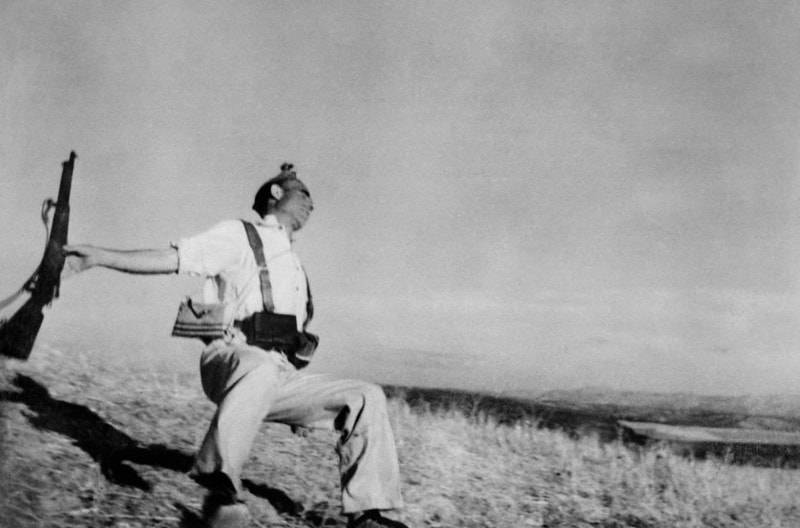
Taken near Córdoba in the early months of the war, the photograph captures a soldier struck by a bullet. It made its debut in the 23rd issue of the French magazine Vu and soon became an iconic representation of the conflict, widely reprinted, and one of the most famous war photographs in history. Just two years after this picture was published, the British magazine Picture Post hailed the 25-year-old photographer as the world’s best war photographer.
Capa’s audacious approach to capturing the image is also noteworthy. He was known for his fearless and intimate style of war photography, often placing himself remarkably close to the heart of the action. In the case of this photo, he reportedly embedded himself with the soldiers on the front lines, capturing the raw and immediate essence of the conflict.
The controversy surrounding “Falling Soldier” centers on its authenticity. Over the years, there has been ongoing debate and skepticism regarding whether the photograph was staged or genuinely captured in the heat of battle. Some critics argue that the image may have been posed, while others maintain that it authentically portrays a soldier in the midst of combat. Regardless of these controversies, the photo endures as a powerful and lasting symbol of the Spanish Civil War and the harsh realities of armed conflict.
The image depicts the soldier’s rifle falling alongside the soldier’s body as it crumples to the ground, conveying the fragility and the suddenness with which death can overtake a human being.
3. Migrant Mother – Dorothea Lange – 1936
“Migrant Mother from Nipomo,” a photograph taken by Dorothea Lange in her home state of California, stands as an emblematic icon depicting the harsh realities endured by Americans during the Great Depression of the 1930s. This image is arguably the most well-known from the project commissioned by the Farm Security Administration, aimed at capturing the profound impact of the Great Depression on American families.
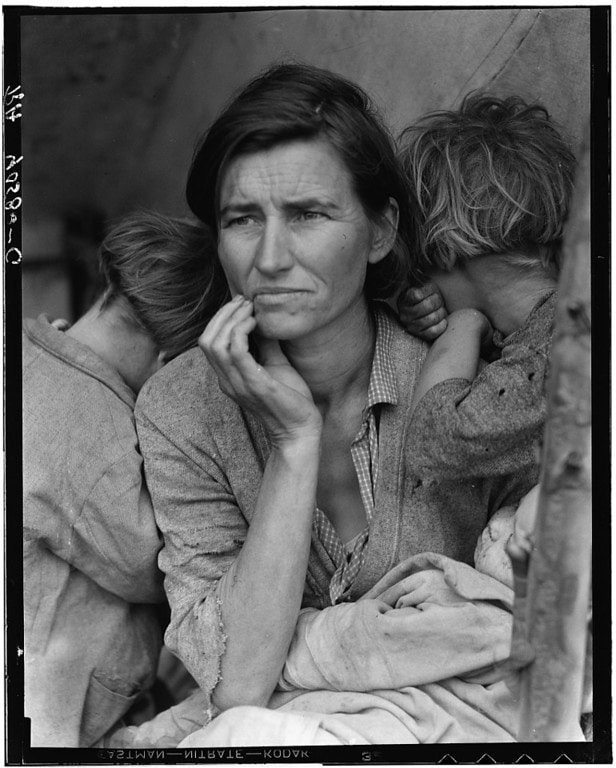
Dorothea Lange explained that she encountered this woman while working on the journalistic project. The subject was a mother of seven children, and it took as little as ten minutes to capture their moment. The image authentically portrays a fleeting moment in time.
This photograph serves as the archetype representing the victims of economic hardship, with the initial focus on one individual. Interestingly, Dorothea Lange did not disclose the name of the woman, and it wasn’t until decades later that she was identified as Florence Owens Thompson, a resident of the Cherokee territories in Oklahoma at that time. The photographer’s decision to withhold the name adds complexity to the role of a photojournalist in documentary work. However, I believe she recognized the image’s significance as an archetype, rendering the name unnecessary. On the contrary, Florence Owens Thompson later expressed discomfort with her image being the enduring symbol of poverty. Remarkably, the image is also a part of MoMA’s collection.
When we study the image, Florence is undeniably the central focus. Lange had a fascination with hands as symbols of the hard work that many people endured for their livelihoods, and in this photograph, the hands convey an added layer of concern. Notably, the image features three children: two children are positioned on either side of Florence, while a vulnerable-looking baby is situated in the center, surrounded by the harsh realities of the Great Depression.
In essence, the punctum of the image is the worry evident in Florence’s eyes and hands, while the studium of the image encapsulates the challenging context of raising a large family amidst the struggles of the depression.
4. Hyeres – Henri Cartier-Bresson – 1932
Cartier-Bresson was renowned for his unyielding approach of not cropping his images and presenting them exactly as they were framed in-camera. He frequently expounded on the concept of the “Decisive Moment,” which can be succinctly defined as the ability to capture a moment just before it unfolds.

While I can’t recall the exact source, I distinctly remember him saying that if you had already seen the moment, it had already transpired, and as a photographer, one must possess the foresight to perceive the moment before it materializes.
The image known as “Hyères” by Cartier-Bresson serves as an exemplary illustration for comprehending composition. Throughout the photograph, we encounter the rule of thirds, notably evident on the bicycle rider, as well as leading lines that are prevalent everywhere, from the sidewalk to the conspicuous swirl on the handrail of the stairs. Furthermore, the utilization of a slow shutter speed imparts a profound sense of movement and dynamism to the rider as they exit the scene.
This photograph was captured in Hyères in 1932 and has stood the test of time as an iconic representation of Henri Cartier-Bresson’s work, often featured in various retrospectives. The Decisive Moment is strikingly evident here, skillfully juxtaposing the rider’s freedom with the unyielding structure of the balcony and the railings.
While the image may seem almost accidental, thanks to Cartier-Bresson’s theory of the Decisive Moment, the odds of achieving the intended result were decidedly in his favor. It’s also conceivable that this shot resulted from a patient wait, a crucial aspect of photography that should never be underestimated.
5. Steve Jobs – Albert Watson – 2011
The iconic portrait of Steve Jobs, taken by Albert Watson, perfectly encapsulates his legacy. Soon after his passing, this portrait adorned the landing page of apple.com, making it one of the most significant images of our time. Watson used a 4×5 camera, which adds an ironic twist to the portrait of such an innovative individual.

Technical details aside, the image’s power lies in its simplicity, focusing solely on Jobs. His hand pose suggests constant contemplation, while the subtle smile radiates energy and confidence. The black and white choice eliminates distractions, allowing Jobs’ piercing gaze to engage viewers.
This photograph has become universally recognizable, swiftly achieving iconic status as it circled the globe. Albert Watson’s 2006 portrait captures Steve Jobs in a contemplative and enigmatic pose, emphasizing his intellectual depth and visionary leadership in the tech industry. The meticulous attention to lighting and composition highlights Jobs’ charisma and presence against a minimalist background.
This image is especially significant because it portrays Jobs during a pivotal period in his career, as he led Apple through groundbreaking product releases like the iPhone and MacBook. It serves as a lasting tribute to Jobs, symbolizing his role as a technological pioneer and an emblem of innovation and creative vision. It’s a powerful reminder of the profound impact one person can have on the world through their ideas and determination.
6. Lunchtime atop a Skyscraper – Charles C. Ebbets – 1932
“Lunchtime atop a Skyscraper,” captured by Charles C. Ebbets in 1932, is a famous photograph that has come to symbolize the indomitable spirit of American workers during the Great Depression and the construction of iconic skyscrapers, specifically the 30 Rockefeller Plaza in Manhattan.
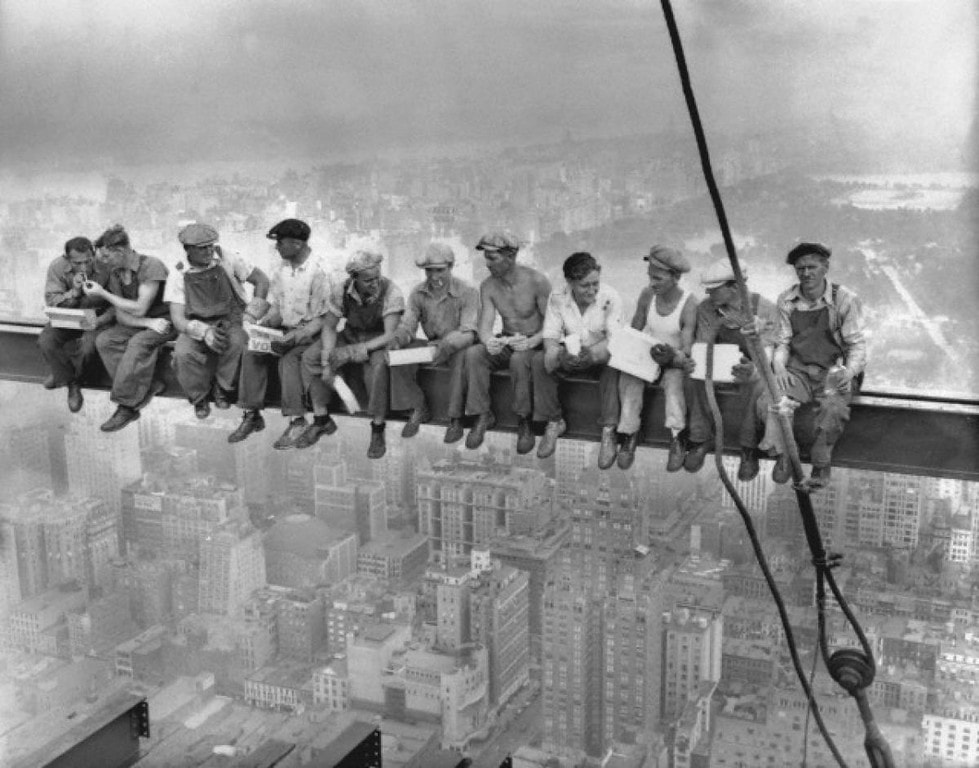
The significance of this photograph lies in its portrayal of the courageous construction workers who risked their lives daily while building the towering skyscrapers that defined the New York City skyline. In a seemingly precarious and breathtaking scene, 11 construction workers nonchalantly sit on a steel beam high above the city streets. Some eat their lunches, while others rest, all with their legs dangling over the edge. It serves as a potent symbol of American resilience, grit, and determination in the face of adversity.
Ebbets’ photograph was taken on the 69th floor of the GE Building during the construction of the Rockefeller Center. He used a large-format camera to capture this remarkable moment, which adds to the image’s clarity and sharpness.
Controversy has surrounded the photograph regarding the identities of the workers and the authenticity of the scene. For many years, the identities of the workers remained unknown, leading to various claims and debates about their true identities. Moreover, some critics raised questions about whether the photograph was staged or a spontaneous capture of a real moment.
Regardless of these controversies, “Lunchtime atop a Skyscraper” remains an enduring symbol of the American can-do spirit, the daring of construction workers, and the construction boom of the 20th century.
7. V-J Day in Times Square – Alfred Eisenstaedt – 1945
It’s fitting that the image marking the end of World War II was created by the hands and eyes of a Jewish photographer. In this image, we witness a powerful moment where two of the most iconic symbols of the war come together in a profound and passionate kiss.

The photograph’s subjects, later identified as George Mendonsa, the sailor, and Greta Zimmer Friedman, the nurse, embody the joy, relief, and excitement that surged through the nation upon hearing the news of the war’s end.
These two symbols represent not only the individuals involved but also serve as the anonymous representatives of the countless sailors and nurses who tirelessly worked during the war. Both of these groups played pivotal roles in upholding the United States’ strength throughout the horrors of the conflict. The celebration captured in this photograph signifies the conclusion of a violent and bloody chapter in modern history, taken in Times Square, New York City.
Their identities remained unknown for some time, but eventually, George and Greta were recognized as the iconic figures in this historic photograph.
Another image, taken from a slightly different angle, is worth noting. However, the iconic one, most likely due to its perspective and composition, is the shot by Alfred Eisenstaedt. Nevertheless, the less-known image by Victor Jorgensen also holds its own by encapsulating the essence of this monumental moment in the War.
This image purposefully blurs the distinction between the two faces within the frame, reinforcing the significance of these symbolic figures.
8. Einstein’s Birthday – Arthur Sasse – 1951
Often referred to as “Einstein’s Tongue,” this image has achieved iconic status thanks to its playful and humorous character. Humor, in itself, demands a degree of intelligence, and capturing humor in candid photography is among the most challenging aspects of this discipline. The photograph offers a different perspective on Albert Einstein, revealing a side of him that is lighthearted and a touch eccentric, which contributes to its greatness.

This memorable moment unfolded during the 72nd birthday celebration of Albert Einstein, an occasion attended by numerous photographers. However, it was Jean Sasse who managed to capture the shot that would become iconic. In this image, we are presented with a side of Albert Einstein that is both relatable and endearing, a departure from the Nobel prize-winning physicist renowned for his theory of general relativity.
What adds an intriguing layer to the image’s background is that Einstein was so fond of it that he requested the UPI (United Press International) to provide him with nine copies of the cropped image for his personal use. One of these copies found its way to Howard K. Smith, a friend of Einstein. Interestingly, a brief message adorns the back of the image, which reads, “This gesture you will like because it is aimed at all of humanity. A civilian can afford to do what no diplomat would dare.“
9. Guerrillero Heroico – Alberto Korda – 1960
Much like V-J Day was fittingly captured by a Jewish photographer, the scene of Ernesto “Che” Guevara feels appropriately captured by a Cuban lens. While Guevara was Argentinian, his close friendship with Fidel Castro establishes a significant connection to the Cuban perspective. The image, indeed, was taken by a Cuban, Alberto Diaz Gutierrez, known as Alberto Korda, who served as Fidel Castro’s official photographer for nine years and accompanied him on numerous international journeys.

Ernesto “Che” Guevara was the subject of various remarkable photographs, including the one taken by Rene Burri. However, the one that most enduringly immortalizes his heroic persona is Korda’s, without a shadow of a doubt. This image has been widely disseminated, adorning flags, t-shirts, and stickers. The story behind this iconic image is equally compelling. On March 4, 1960, the French freight ship La Coubre was transporting weapons from Belgium to Cuba to support Castro’s regime when it exploded, with Castro alleging U.S. involvement.
The tragic incident claimed the lives of over 75 individuals, and the following day, a solemn funeral was held in Havana. While speakers delivered their eulogies, Alberto Korda captured two candid images of Guevara. Unbeknownst to Guevara at the time, these photographs evolved to become not merely iconic but profoundly symbolic.
Interestingly, Alberto Korda was never content with the commercial use of the image as it contradicted Che’s own beliefs, the very ideals he had sacrificed his life for.
10. General Nguyen Ngoc Loan Executing a Viet Cong Prisoner – Eddie Adams – 1968
It’s been said that no other group of photojournalists had the freedom to document the horrors of war quite like those who roamed the brutal landscapes of the Vietnam War. Here, we confront one of the most harrowing images ever captured by a photographer, an image that earned Eddie Adams the Pulitzer Prize in 1969.

In a brief video, Eddie Adams himself explains the sequence of events. It feels like the genuine and immediate response of a dedicated photographer. He witnessed the officer raising his gun and instinctively raised his camera. The resulting image attained iconic status almost instantaneously and stands as a stark testament to the horrors of war.
This photograph, beyond a shadow of a doubt, stands as the most iconic image of the Vietnam War. Its power lies in its proximity to the precise moment one man takes another man’s life. The uniformed South Vietnamese officer coldly executes a prisoner with a gunshot to the head, and the brutality of that instant got immortalized through the lens of photography. This exemplifies the profound importance of photojournalism: it allows us to remember moments that we hope will never be repeated.
11. The Mahatma – By Margaret Bourke – 1946
Margaret Bourke-White’s photograph of Mahatma Gandhi, titled “The Mahatma,” is an iconic image that profoundly symbolizes the life and philosophy of this great leader of nonviolent resistance during India’s struggle for independence. Captured in 1946, the photograph portrays Gandhi at his spinning wheel, serving as a potent symbol of his dedication to self-sufficiency and nonviolent resistance.

The backstory of this photograph is both captivating and symbolically rich. Margaret Bourke-White, one of the privileged few to photograph Mahatma Gandhi, spent time with him at his ashram in India. When she attempted to capture the image with Gandhi near the spinning wheel, his secretaries intervened and insisted that if she wanted to create an image with that precise composition, she needed to learn how to operate a spinning wheel herself.
Gandhi’s attire in this photograph, characterized by a traditional dhoti and shawl, reflects his unwavering commitment to simplicity and his rejection of materialism. “The Mahatma” by Margaret Bourke-White transcends being just a portrait; it stands as a powerful representation of Gandhi’s peaceful resistance and steadfast devotion to the principles of truth and nonviolence. Over time, it has become an enduring symbol of his legacy and the ideals he championed during India’s struggle for independence.
LIFE magazine’s first woman photographer was in India in 1946, covering the Indian independence process.
12. Tank Man – Jeff Widener – 1989
The famous photograph titled “Tank Man,” captured by Jeff Widener during the 1989 Tiananmen Square protests in Beijing, holds a profound and iconic significance. It symbolizes the indomitable spirit of an individual facing authoritarianism and oppression.

Story Behind It: This poignant image was taken on June 5, 1989, just a day after the Chinese government had dispatched troops and tanks to brutally suppress the pro-democracy demonstrations in Tiananmen Square. The aftermath of the government’s crackdown had left the square in disarray, strewn with debris and destruction.
Jeff Widener, an Associated Press (AP) photographer, was in Beijing to cover the unfolding protests. He received a tip that something was happening at Tiananmen Square, although it had been sealed off to the press. Widener, accompanied by a small group of journalists, ventured to the Beijing Hotel, which provided an elevated view of the square.
From a fifth-floor balcony, Widener had an unobstructed view of the square. It was from this vantage point that he captured the iconic image of an unidentified Chinese man standing boldly in front of a line of tanks, preventing their advance.
The identity of “Tank Man” remains unknown, as the Chinese government has kept a tight grip on information regarding the protests and their consequences.
How It Was Taken: Jeff Widener employed a Nikon FE2 camera equipped with a 300mm telephoto lens to capture the image. The physical distance between the photographer and the scene emphasized the stark juxtaposition between the solitary individual and the formidable military machinery he confronted.
Widener’s photograph rapidly gained international recognition, becoming an enduring symbol of the struggle for human rights and freedom against oppressive regimes. It has etched a lasting impression in the collective memory of the Tiananmen Square protests and continues to serve as a potent and timeless representation of individual courage in the face of tyranny and oppression.
World Famous Photos | Conclusion
In conclusion, these twelve photos are some of the world’s most famous and well-known images. Each one has an interesting story that helps add context and depth to the photo. These stories provide a glimpse into different cultures and historical moments and help us better understand the world around us.

